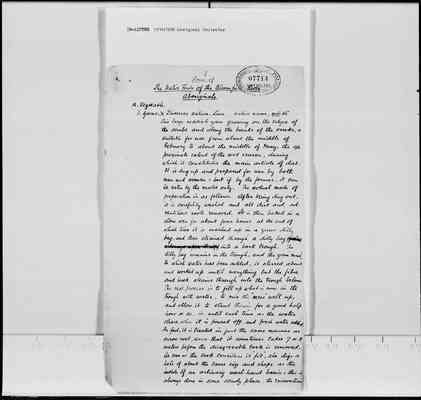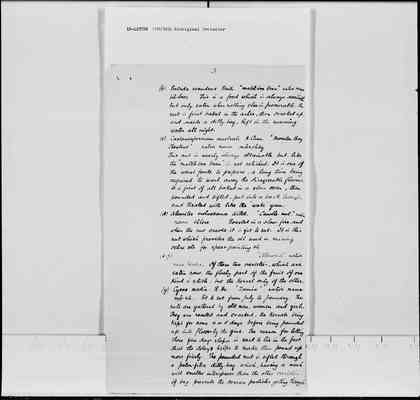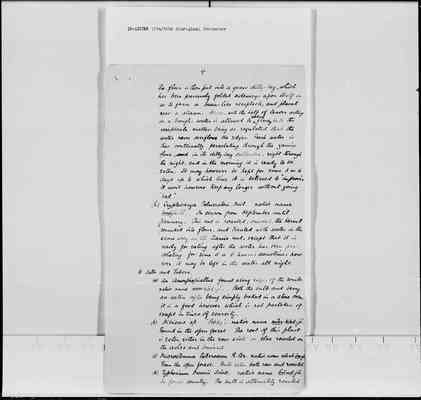Pages
1
[seal] Commissioner of Police 07714 Queensland 23.Jun.1898
Cooktown 13 May 1898
The Commissioner of Police Brisbane
Sir
I have the honor to forward you an account of "Some of the Native Foods of the Bloomfield River Aboriginals": there are still a number of plants and animals requiring scientific identification, but this can only be done by collecting the actual specimens and sending them down to Brisbane—both Mr Hislop and Mr Bailey have taken a deal of trouble in this way.
The country will soon be fit for travelling now, and I trust that you will soon be able to visit the north. Of course, if in two or three weeks time, circumstances should arise to prevent your coming, I might suggest the advisability of visiting, and studying at some of the native Police Camps e.g. a month or so each at Highbury, the Musgrave, the Coen etc: I could do some very valuable scientific work by such means. So far as official routine is concerned at Cooktown, there is but little to be done now in view of my various reports re Mission Station Reserves, etc which I we already been forwarded to you.
At any rate, in the meantime, I am finishing up all my MSS which is on hand, and completing the drawings. With regard to the Rockhampton MSS. I have been in communication with some of the very "old hands," e.g. Wyndham of Boyne Island (the first resident on the Keppels), Roe of Miriam Vale, Flowers from Broadsound (and now of Bogantungan) etc, and have collected so much new matter that it will be necessary to rewrite it.
Sub-Inspector Garraway is also collecting information and making drawings etc, at Highbury.
I have the honour to be Sir Your obedient servant Walter E Roth
The Australian Medical Gazette has given me a eulogistic notice.
2
[seal] Commissioner of Police 07714 Queensland 5.Jun.1888
1
The Native Foods of the Bloomfield River Aboriginals.
A. Vegetable.
i. Yams. (a) Dioscorea sativa, Linn. native name, wō-kī, This large reddish yam growing on the edges of the scrubs and along the banks of the creeks, is suitable for use from about the middle of February to about the middle of May, the approximate extent of the wet season, during which it constitutes the main article of diet. It is dug up and prepared for use by both men and women: but if by the former, it can be eaten by the males only. The actual mode of preparation is as follows. After being dug out, it is carefully washed and all dirt and adventitious roots removed. It is then baked in a stone oven for about four hours at the end of which time it is mashed up in a grass dilly bag, and then strained through a dilly bag into a bark trough. The dilly bag remains in the trough, and the yam "mush", to which water has been added, is stirred about and worked up until everything but the fibre and husk strains through into the trough below. The next process is to fill up what is now in the trough with water, to mix the "mess" well up, and allow it to stand therein for a good half hour or so. ie. until such time as the water clears, when it is poured off, and fresh water added. In fact, it is treated in just the same manner as arrow-root, save that it sometimes takes 7 or 8 waters before the disagreeable taste is removed. As soon as the cook considers it fit, she digs a hole of about the same size and shape as the inside of an ordinary wash-hand basin: this is always done in some sandy place, the excavation
3
2
being lined with clean sand. Into this hole the now semi-liquid mass is gently poured, and when the water is all drained off it is ready for eating, the prepared article looking much like the ordinary preserved (tinned) potato, but slightly more grey in colour. It has to be eaten the same day it is prepared, as fermentation quickly takes place. The females are invariably allowed to eat this particular yam when prepared by themselves: the young men and boys (even if it prepared by males) cannot eat it from the time they pass the last initiation ceremony until the lapse of a certain interval (fixed by the Elders) depending upon the seasons—a lapse of generally about 9 months.
The following three yams which have not yet been identified are sometimes eaten raw; more generally they are cooked, either by roasting on, or baking in, the ashes:
(b) nat. name Kal Koor. A long white yam growing in the forest country.
(c) n.n. Kou-oo. Also a long white yam but growing in the scrubs, mostly on the hills and in rocky places.
(d) n.n. Mârmè. A short white yam growing mostly on the exposed ridges facing the sea.
ii. Nuts
(a) Pygeum Turnerianum. Bail native name joon-dã. (Bailey says that the aboriginals at Cairns call this "abill") In season from January to March. It is only used quite fresh, as the fruit-husk shell and Kernel is pounded up together, sifted through a palm-tree dilly bag, after which the resulting meal is damped, kneaded into cakes, wrapped in wild-ginger leaves and baked in the ashes.
4
3
(b). Entada scandens Benth. "match-box bean" native name bâ boor. This is food which is always available but only eaten when nothing else is procurable. The nut is first baked in the ashes, then cracked up, and, inside a dilly-bag, left in the running water all night.
(c) Castanospermum australe A. Cunn. "Moreton Bay Chestnut" native name mârchày This nut is nearly always obtainable but, like the "match-box bean" is not relished. It is one of the worst foods to prepare, a long time being required to wash away the disagreeable flavour. It is first of all baked in a stone oven, then pounded and sifted, put into a bark trough, and treated with like the "woki" yam.
(d) Aleurites moluceana Willd. "Candle-nut", native name belere. Roasted in slow fire, and when the nut cracks, is fit to eat. It is this nut which provides the oil used in mixing ochre etc for spear-painting etc
(e.f.) "Almond" native name berka. Of these two varieties, which are eaten raw, the fleshy part of the fruit of one kind is edible, but the Kernel only of the other.
(g) Cyea media. R. Br. "Zamia", native name mâ-rä. Fit to eat from July to January. The nuts are gathered by old men, women and girls. They are roasted and cracked, the Kernels being kept for some 4 or 5 days before being pounded up into flower [sic] by the gins. The reason for letting these few days elapse is said to lie in the fact that the delay helps to make them pound up more finely. The pounded nut is sifted through a palm-fibre dilly-bag, which, having a mesh with smaller interspaces than the other varieties of bag prevents the coarser particles getting through
5
4.
The flour is then put into a grass dilly-bag, which has been previously folded sideways upon itself so as to form a basin- like receptacle, and placed near a stream. Hence, with the help of leaves acting as a trough, water is allowed to continue flowing into the receptacle, matters being so regulated that the water never overflows the edges. Fresh water is thus continually percolating through the zamia flour, in its dilly-bag callender, right through the night, and in the morning it is ready to be eaten. It may however be kept for some 3 or 4 days up to which time it is believed to "improve": it won't however keep any longer without going "bad".
(h) Cryptocarya Palmerstone, Bail. native name boodjā-bī. In season from September until January. This nut is roasted, cracked, the kernel pounded into flour, and treated with water in the same way as the Zamia nut, except that it is ready for eating after the water has been percolating for some 5 or 6 hours: sometimes, however it may be left in the water all night.
iii. Bulbs and Tubers
(a) An Amorphophallus found along edges of the scrubs. native name woo-räd jī. Both the bulb and berry are eaten after being simply baked in a stone oven: it is a food however which is not partaken of except in times of scarcity.
(b) Hibiscus sp. "Poppy". native name mâr-Käd-jī. Found in the open forest. The root of this plant is eaten either in the raw state or else roasted on the ashes and bruised.
(c) Microstemma tuberosum R. Br. native name wâ-zâ-boo-gä From the open forest. Bulb eaten both, raw and roasted.
(d) Typhonium Brownii Schott. native name bünd-jă In forest country. The bulb is alternately roasted




